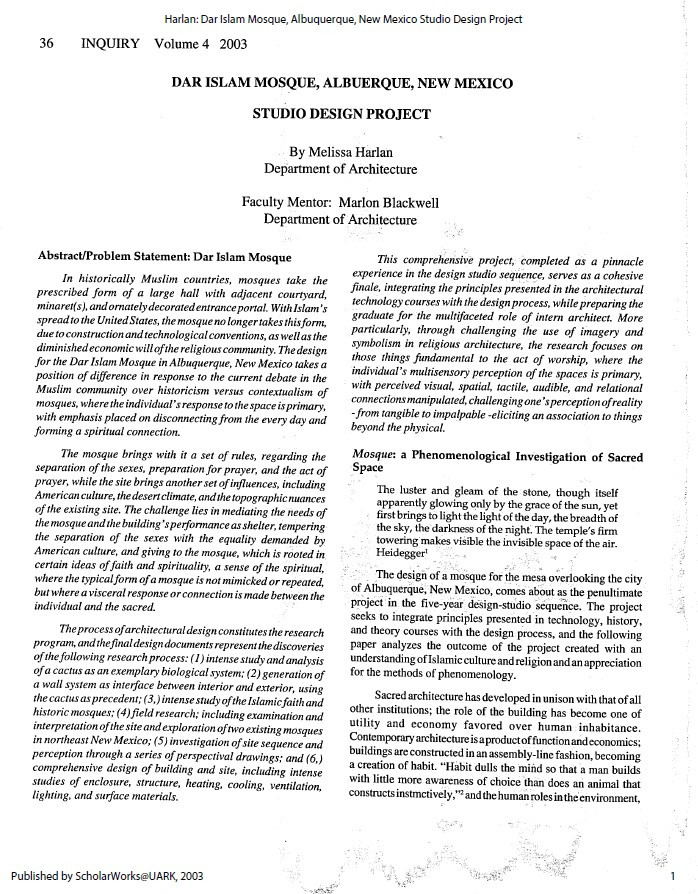
In historically Muslim countries, mosques take the prescribed form of a large hall with adjacent courtyard, minaret(s), and ornately decorated entrance portal. With Islam’s spread to the United States, the mosque no longer takes this form, due to construction and technological conventions, as well as the diminished economic will of the religious community. The design for the Dar Islam Mosque in Albuquerque, New Mexico takes a position of difference in response to the current debate in the Muslim community over historicism versus contextualism of mosques, where the individual’s response to the space is primary, with emphasis placed on disconnecting from the every day and forming a spiritual connection. The mosque brings with it a set of rules, regarding the separation of the sexes, preparation for prayer, and the act of prayer, while the site brings another set of influences, including American culture, the desert climate, and the topographic nuances of the existing site. The challenge lies in mediating the needs of the mosque and the building’s performance as shelter, tempering the separation of the sexes with the equality demanded by American culture, and giving to the mosque, which is rooted in. certain ideas of faith and spirituality, a sense of the spiritual, where the typical form of a mosque is not mimicked or repeated, but where a visceral response or connection is made between the individual and the sacred. The process of architectural design constitutes the research program, and the final design documents represent the discoveries of the following research process: (I) intense study and analysis of a cactus as an exemplary biological system; (2) generation of a wall system as interface between interior and exterior, using the cactus as precedent; (3) intense study of the Islamic faith and historic mosques; (4)field research; including examination and interpretation of the site and exploration of two existing mosques in northeast New Mexico; (5) investigation of site sequence and perception through a series of perspectival drawings; and (6,) comprehensive design of building and site, including intense studies of enclosure, structure, heating, cooling, ventilation, lighting, and surface materials. This comprehensive project, completed as a pinnacle experience in the design studio sequence, serves as a cohesive finale, integrating the principles presented in the architectural technology courses with the design process, while preparing the graduate for the multifaceted role of intern architect. More particularly, through challenging the use of imagery and symbolism in religious architecture, the research focuses on those things fundamental to the act of worship, where the individual’s multisensory perception of the spaces is primary, with perceived visual, spatial, tactile, audible, and relational connections manipulated, challenging one’s perception of reality -from tangible to impalpable -eliciting an association to things beyond the physical.
I agree to the terms outlined below:
You agree to upload and assign Mosqpedia Database the rights to use the content worldwide and in perpetuity across all current and future media platforms. Mosqpedia Database may edit, copy, adapt and translate your contribution.
The content will be distributed under the Creative Commons Attribution-Deed – Attribution-NonCommercial-NoDerivatives 4.0 International – Creative Commons
All data will be stored in line with data protection regulations.